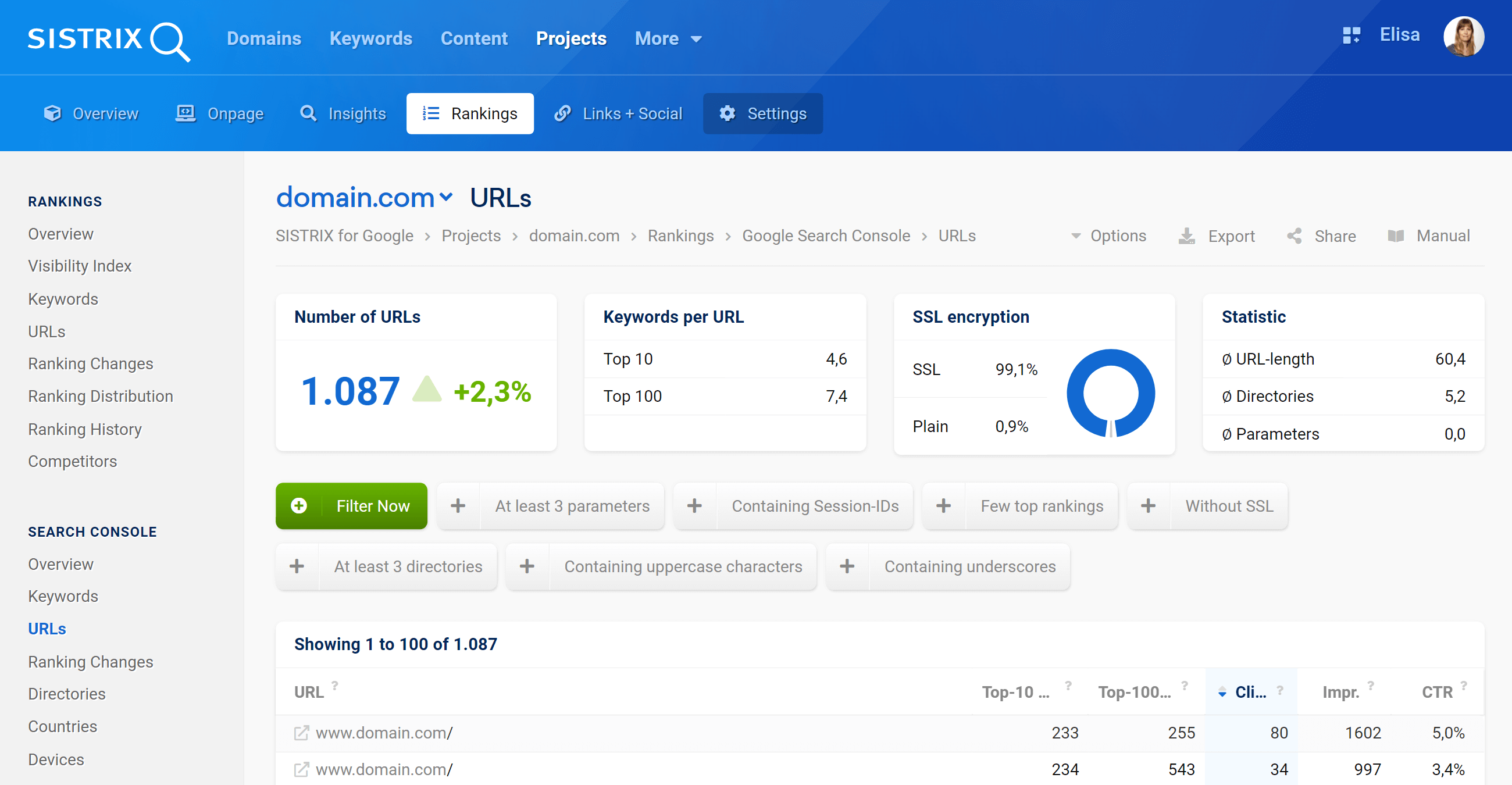In this section of your Onpage project you’ll find all the important performance figures the relate to the URLs on your website, as imported directly from Google Search Console. Video walk-through below.
If you linked your website’s property to the SISTRIX Toolbox you can access your extended Search Console data within the project and have access to a number of key values from the Google Search Console.

Number of URLs
In the first box you will see the number of URLs for this domain which rank for at least one keyword in Google’s Top-100 result.
The arrow will show you if there has been an increase or decrease in overall ranking URLs since last week.
Keywords per URL
Here we will show you the average amount of keywords within the Top-10 and Top-100 for which individual URLs are ranking.
SSL Encryption
Here you can see how many of the ranking URLs use the HTTPS (SSL) protocol and how many only use HTTP.
Statistic
This box will show you the average length, architectural depth (directory levels) and number of added parameters for all ranking URLs. In most cases, there is no reason why you should have more than 3 directory levels within your website architecture and you should try to avoid parameters altogether.
URLs
Filters
The filters allow you to further refine your list of URLs and eventually discover features that could be optimized.
Some filters are immediately available on the interface (Quick Filters), while others can be selected by clicking on the green button “Filter now“.
Here’s a quick explanation of every avaliable filter for the URLs:
- URL: finds the URLs that contain (or do not contain) the given text. For example, the quick filter “Contains underscores” lets you quickly find all the URLs with this feature, which is particularly important because Google recommends using hyphens instead of underscores in URLs.
- Number of parameters: filters the URLs according to a specific number of parameters. Note that URLs which have more than 3 parameters are to avoid, because they are extremely vulnerable to Duplicate Content problems. That’s why we created the quick filter “At least 3 parameters“.
- Number of directories: filters the URLs according to a specific number of directories. Thanks to the quick filter “At least 3 directories” you can find those URLs that are deep in the website architecture, which run the risk of not being crawled as often by Google (or at all) compared to URLs higher up in the structure.
- Top-10 ratio: indicates how many Top-100 keywords are also ranking in Google’s first result page. The quick filter “Few top rankings“, for example, shows you all those URLs that are ranking on the first organic page with less than 3% of their Top-100 keywords: you might want to check if you want these URLs in Google’s index.
- Containing Session IDs: filters the URLs that contain (or do not contain) Session IDs. Note that Session IDs can easily cause duplicate content problems, so it could be a good idea to check why your system is providing Session IDs to users and to Googlebot.
- Containing uppercase characters: shows only the URLs which have uppercase characters. It is always better to avoid using uppercase characters in URLs, as upper and lower-case letters are technically different URLs which may get you in trouble when it comes to setting up 301 redirects.
- SSL encryption: shows the URLs that use (or don’t use) HTTPS protocol: this is particularly useful for those URLs that are still not secure (quick filter: “Without SSL“).
Table
In this table we show you all the URLs that are ranking in the Top 10 and Top 100 across all the project keywords.
By default, the table is sorted by the amount of Top-100 rankings. You can change this with a click on the column heading you want to sort.